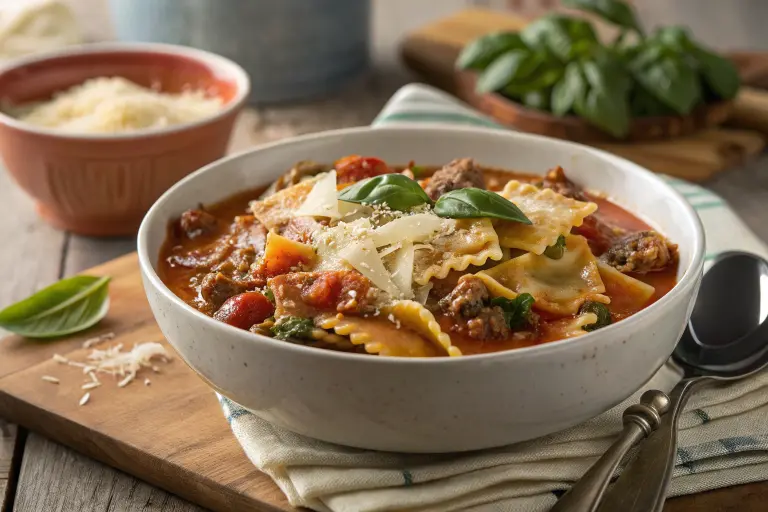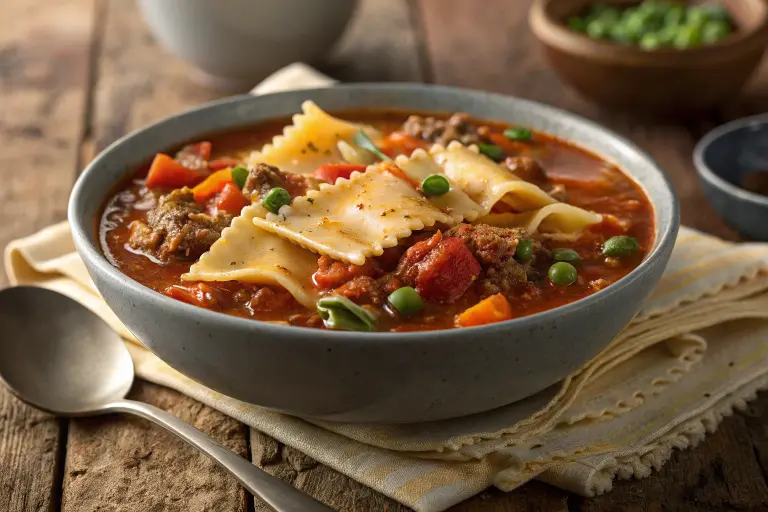Lasagna soup is a comfort food favorite, combining all the hearty, savory flavors of traditional lasagna in a cozy, liquid form. It’s perfect for those cold nights when you crave something warm and filling. But if you’re watching your carbohydrate intake, you might ask yourself: How many carbs are in lasagna soup? Whether you’re following a low-carb, keto, or diabetic-friendly diet, understanding the carb content of this dish is essential to making informed choices about what you eat.
In this article, we will take a closer look at how many carbs are in lasagna soup and explore how the ingredients contribute to the overall carbohydrate count. From traditional pasta to various low-carb alternatives like zucchini noodles or shirataki noodles, we’ll help you determine the best options for your dietary needs.
Knowing how many carbs are in lasagna soup is especially important for those who must carefully manage their carbohydrate intake. For example, if you’re on a keto or diabetic diet, you might need to adjust your recipe to make it more compatible with your health goals. Don’t worry we’ll show you how to enjoy this delicious dish without going overboard on carbs. By the end of this article, you’ll have all the information you need to enjoy lasagna soup without compromising your diet.
What Is Lasagna Soup?
Lasagna soup is a twist on the traditional Italian lasagna dish. It typically includes ingredients like ground meat (beef, turkey, or pork), diced tomatoes, pasta, and a variety of seasonings such as garlic, basil, and oregano. Some recipes also include cheese, either mixed into the soup or sprinkled on top.
Unlike traditional lasagna, which uses layers of noodles, lasagna soup has a broth-based consistency that allows you to enjoy the same flavors in a more liquid form. The dish has gained popularity for its hearty texture and rich, comforting taste.
However, as with any dish that includes pasta, it’s important to consider how many carbs are in lasagna soup to understand its nutritional impact.
The Ingredients That Impact Carbs in Lasagna Soup
The carb content in lasagna soup comes from several ingredients, particularly the pasta and any added vegetables or legumes. Here’s a breakdown of the key ingredients that contribute to the total carbohydrate count:
1. Pasta
Pasta is one of the main ingredients that increase the carbohydrate count in lasagna soup. The type of pasta used can make a difference in the total carbs. Traditional wheat-based pasta can add around 40 grams of carbs per serving, while whole wheat or gluten-free options may have slightly fewer carbs.
- Traditional pasta: 40 grams of carbs per serving (1 cup cooked)
- Whole wheat pasta: 37 grams of carbs per serving
- Gluten-free pasta: 35 grams of carbs per serving
2. Tomatoes and Tomato Sauce
Tomatoes, whether fresh or in sauce form, are a low-carb ingredient. A ½ cup of tomato sauce or fresh tomatoes has roughly 4 grams of carbs. While this is not a large contribution, it adds to the total carb count in the soup.
3. Ground Meat
Meat, including beef, turkey, or sausage, is a source of protein and does not significantly add carbs to the dish. However, certain types of sausage might include fillers that contain carbs, so it’s always good to check the label.
4. Cheese
Ricotta, mozzarella, and Parmesan cheeses are commonly used in lasagna soup. These cheeses are low in carbohydrates but can add a small amount of carbs, especially ricotta. On average, a ¼ cup of ricotta cheese has about 4 grams of carbs.
5. Herbs and Spices
Herbs like basil, oregano, and garlic don’t contribute significantly to the carbohydrate count. However, they add flavor and nutritional value to the dish without increasing carbs.

How Many Carbs Are in Lasagna Soup? A Breakdown
When it comes to lasagna soup, the carbohydrate content can vary significantly based on the ingredients you use. The dish is versatile and can be adapted to meet a wide range of dietary needs, which makes it a popular choice for those looking for a hearty, satisfying meal. However, if you’re specifically concerned about the number of carbs in lasagna soup, it’s important to consider the type of pasta, sauce, and other ingredients included in the recipe.
Traditional Lasagna Soup with Pasta: 30-40 Grams of Carbs
In a classic lasagna soup recipe made with traditional pasta, the carbohydrate content can be relatively high. On average, a serving of lasagna soup (1 to 1.5 cups) prepared with regular pasta will contain approximately 30 to 40 grams of carbs. The pasta plays a key role in the carb count, with regular pasta contributing around 40 grams of carbs per serving (about 1 cup of cooked pasta). Add to that the other ingredients such as tomato sauce, ground meat, and cheese, and you’re looking at a filling meal that still falls within the typical carb range for a comfort food dish.
Here’s a rough breakdown of how the ingredients in traditional lasagna soup contribute to the carb content:
- Pasta: 40 grams of carbs (for 1 cup of cooked traditional pasta)
- Tomato Sauce: 4 grams of carbs per ½ cup (depending on the type of sauce)
- Cheese (Ricotta, Mozzarella): 4 grams of carbs per ¼ cup
- Ground Meat: Negligible carbs
As you can see, while the pasta is the primary source of carbohydrates, the other ingredients have a minimal impact on the overall carb count. So if you’re enjoying traditional lasagna soup, the carb content will primarily depend on the amount and type of pasta you choose.
Low-Carb Lasagna Soup with Zoodles (Zucchini Noodles): 10-12 Grams of Carbs
If you’re on a low-carb diet or specifically following a keto or diabetic-friendly plan, you might want to know how many carbs are in lasagna soup when it’s made with zucchini noodles instead of regular pasta. Zucchini noodles (or “zoodles”) are a fantastic low-carb substitute that allows you to enjoy the hearty texture of lasagna soup without the carb-heavy pasta.
By replacing regular pasta with zoodles, you can reduce the carb content of your lasagna soup by up to 70-80%. Typically, a serving of low-carb lasagna soup made with zucchini noodles contains around 10 to 12 grams of carbs per serving (1 to 1.5 cups). Here’s why zucchini noodles are a great alternative:
- Zucchini Noodles (Zoodles): Approximately 3 grams of carbs per cup
- Tomato Sauce: Still about 4 grams of carbs per ½ cup
- Cheese: A similar carb count as the traditional recipe, at 4 grams of carbs per ¼ cup
- Ground Meat: No carbs
In this version of lasagna soup, most of the carbs are still coming from the tomato sauce and cheese, but substituting zucchini noodles for pasta significantly reduces the carb count. This makes the low-carb version of lasagna soup a perfect choice for those looking to minimize their carbohydrate intake while still enjoying a comforting, flavorful meal.
Keto Lasagna Soup: 5-7 Grams of Carbs
For those on a strict keto diet, the goal is typically to stay under 20 grams of net carbs per day. If you’re wondering how many carbs are in lasagna soup on a keto-friendly version, the carb content can be reduced even further by using keto-friendly substitutes.
The carb count can range from 5 to 7 grams per serving in a keto version of lasagna soup. To make this version, you can swap out the regular pasta for shirataki noodles, a low-carb noodle made from the konjac root. Shirataki noodles contain almost no carbs, making them a perfect option for anyone following a keto or very low-carb diet.
Here’s how the carb breakdown looks in a keto lasagna soup recipe:
- Shirataki Noodles: 0-1 grams of carbs per serving
- Tomato Sauce: 4 grams of carbs per ½ cup
- Cheese: 4 grams of carbs per ¼ cup
- Ground Meat: No carbs
Using shirataki noodles and keeping the other ingredients in line with a keto-friendly approach makes it possible to enjoy a nearly carb-free version of lasagna soup. You’ll get the rich flavors of traditional lasagna soup without worrying about exceeding your daily carb limits.
How to Adjust the Carb Count Based on Your Dietary Needs
Now that you know how many carbs are in lasagna soup depending on the type of pasta and ingredients used, you can adjust the recipe to suit your dietary preferences. Whether you’re looking to reduce carbs, follow a keto plan, or simply enjoy a healthier version of lasagna soup, here are some ways to further tweak your recipe:
- Skip the Pasta Altogether: If you want to go even lower in carbs, you can omit the pasta completely. Instead, focus on the soup’s meaty, cheesy, and flavorful aspects. This will reduce the carb count to about 5-7 grams per serving.
- Use Cauliflower or Cabbage: Some low-carb enthusiasts use cauliflower or cabbage in place of noodles. These alternatives add fiber and texture while keeping carbs to a minimum.
- Homemade Tomato Sauce: Opt for homemade tomato sauce that is free from added sugars or starches. This can reduce the carb content of the soup, particularly in tomato-based dishes like lasagna soup.
- Choose Low-Carb Cheeses: Some cheeses have slightly fewer carbs than others. For example, cream cheese can be used as a replacement for ricotta cheese to reduce the carb count. Keep in mind that the difference might only be a few grams, but every little bit helps when you’re watching your carbs closely.

How to Reduce Carbs in Lasagna Soup
If you’re following a low-carb diet, there are several ways to reduce the carbs in lasagna soup without sacrificing flavor. Here are some practical suggestions:
1. Use Low-Carb Noodles
Opt for noodles that are lower in carbs, such as zucchini noodles, spaghetti squash, or shirataki noodles. These options can reduce the carb content significantly.
2. Skip the Pasta
Some people prefer to make lasagna soup without any pasta at all, relying on the other ingredients like meat and cheese for texture and flavor. While this version will be more like a meaty stew, it will have almost no carbs.
3. Use Cauliflower Instead of Pasta
Cauliflower can be used as a low-carb alternative to pasta. By chopping cauliflower into small florets, you can mimic the texture of pasta while keeping the carb content low.
4. Make Your Own Tomato Sauce
Store-bought tomato sauce often contains added sugars and starches, which can increase the carb count. Making your own sauce with fresh tomatoes and herbs can help reduce the overall carbs in the dish.
The Role of Carbs in Lasagna Soup for Diabetics
For individuals managing diabetes, monitoring carb intake is crucial. The good news is that lasagna soup can be part of a balanced meal if you manage the ingredients carefully. Here’s how:
- Choose Low-Carb Alternatives: As mentioned, using zucchini noodles or skipping the pasta altogether can drastically reduce the carb content in lasagna soup.
- Control Portion Size: While lasagna soup is delicious, eating in moderation is key. A small bowl can provide all the flavor without the carb overload.
- Pair with a Salad: Pairing lasagna soup with a side salad (without croutons or sugary dressings) can help balance your carb intake.
- Monitor Your Blood Sugar: Keep track of your blood sugar levels to ensure that your lasagna soup consumption doesn’t cause spikes.
Nutritional Value of Lasagna Soup at a Glance
Here’s a quick overview of the nutritional content of a standard serving of lasagna soup made with traditional pasta:
- Carbs: 35-40 grams per serving
- Calories: 300-350 calories
- Protein: 20-25 grams per serving
- Fat: 15-20 grams per serving
- Fiber: 2-4 grams per serving
If you choose a low-carb or keto version with alternative noodles, the carb count could drop to around 10-15 grams per serving, while the protein content may remain roughly the same.
FAQs: How Many Carbs Are in Lasagna Soup?
❓ How many carbs does lasagna soup have?
A traditional lasagna soup with pasta contains about 30 to 40 grams of carbs per serving. Low-carb versions made with zucchini or shirataki noodles can reduce the carb content to 10 to 12 grams per serving.
❓ Does lasagna have a lot of carbs?
Yes, traditional lasagna made with pasta can be high in carbs, with approximately 40 grams of carbs per serving. However, you can reduce the carb count by using alternatives like zucchini noodles or gluten-free pasta.
❓ How many carbs are in homemade soup?
The carb content in homemade soup depends on the ingredients. For example, vegetable-based soups may have around 15 to 25 grams of carbs per serving, while soups with pasta or potatoes can have more.
❓ How many carbs are in a bowl of pasta fagioli soup?
A typical serving of pasta fagioli soup contains around 30 to 35 grams of carbs, mostly from the pasta and beans. The carb count may vary depending on the recipe and serving size.
Conclusion: How Many Carbs Are in Lasagna Soup?
So, how many carbs are in lasagna soup? The answer really depends on the ingredients you choose. A traditional lasagna soup with pasta typically contains around 30 to 40 grams of carbs per serving. However, by making simple swaps, such as using zucchini noodles or shirataki noodles, you can reduce the carb count significantly, with low-carb versions containing only 10 to 12 grams of carbs per serving. For those following a keto diet, even further carb reduction is possible, bringing the carb count to as low as 5 to 7 grams per serving.
The great news is that lasagna soup can still be a delicious and satisfying meal, no matter your carb goals. Whether you prefer the classic version or a modified, low-carb take, it’s easy to tailor this comforting dish to suit your needs. With just a few changes to the ingredients, you can enjoy all the flavors of traditional lasagna in a bowl while keeping your carbohydrate intake in check.
If you’re looking for more hearty soup recipes, be sure to check out our Chicken Alfredo Soup with Beef and Parmesan Cheese and Alfredo Chicken Noodle Soup. Both of these are delicious alternatives to lasagna soup, offering rich, comforting flavors without compromising your dietary goals.
For more recipes and tips on creating balanced, flavorful meals, visit our platforms of Chaynez Recipes for easy access to all our latest content and social media updates. Don’t miss out on more healthy and tasty ideas that can help you stay on track with your carb-conscious lifestyle






